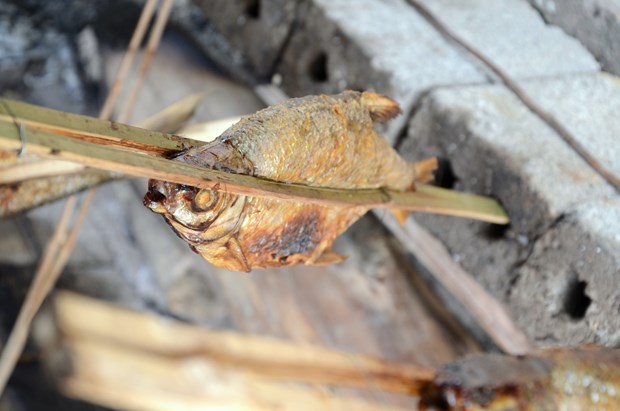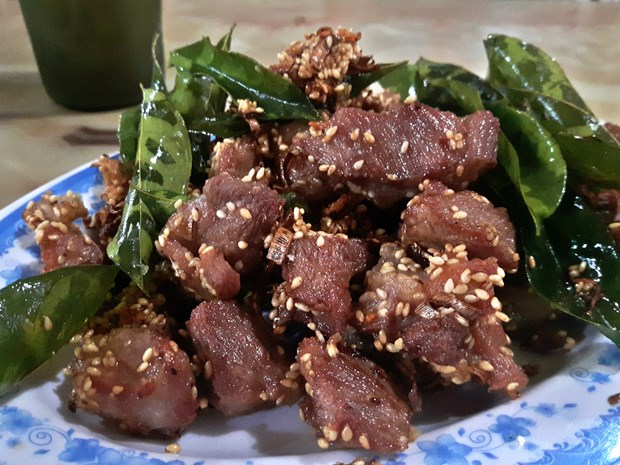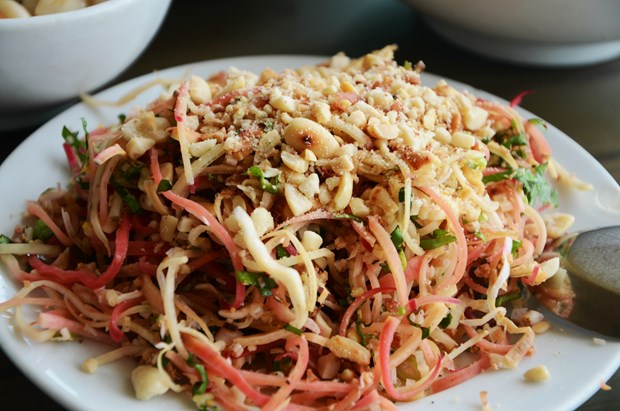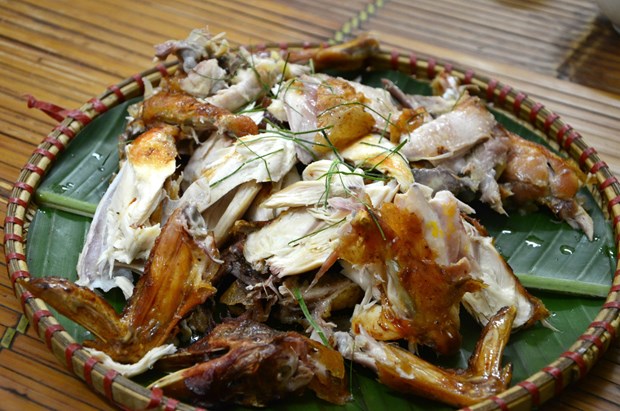Northwest Highlands are a huge treasure of food. In addition of seasonal produce and protein sources, the nature here has been protected by the living habits of the local minorities, from Thai, Mong, Dao, to Tang Mien.
The
protein sources here, besides preys from the forests and fish from streams, are
from poultry and cattle. Unlike industrial farms, minority households have
raised their fowls, mostly chickens and pigs, in their natural habitats; they
let their fowls to feed and live themselves. Therefore, the quality of meat is
significantly better then industrial products.
If
you travel up here, you don’t need to go to luxurious restaurants to find fine
food. Just stopping by any family inn or a stop-n-rest, you can enjoy a very
typical, affordable, and, most importantly, delicious dishes.
Grilled fish from Da
river
Along
the highway 6, especially in Ky Son ward (Hoa Binh province), we can easily see
“instant” stoves, where local vendors grill and sell fresh fish. Ky Son is
located at the bottom of the Da River’s flow, before it massively floods into
the hydroelectric dam in Hoa Binh City so all big fish tend gather here. Due to
the rapid flow of water, fishermen here prefer fishing rods for big fish. Small
fish are for family use; only big fish about 1 kiogram and up are for selling.
This is the most polular specialty in Ky Son: grilled whole luce fish. People
just clean their guts then clip the whole fish by bamboo sticks, grilling on
burning charcoal and let them slowly get cooked.

Grilled whole luce fish from Da river.
This
type of fish is like grilling by a slow cook; it performs an excellent fish
with crispy skin and tender flesh, and also the fish is good for a couple days
in room temperature. The side dish which is sold together, is homemade sour
bamboo shoot. If you can just sit there, right next to the instant charcoal
stove, to have a piece of grilled fish together with sour bamboo and some tiny
herbal leaves, truly it worths the whole trip.
Local pork
Pigs
in the Northwestern highlands are the black pig type, hybridized from wild boar
and local Muong pig. They are quite small compared with regular types; average
is about 25 kilograms but the best size is about 10 – 15 kilograms. Due to
being raised on highlands, the local pigs have to relentless runs for food and
life so the pork is extremely firm, low fat and very delicious.
Among
Hoa Binh province, one of the most common dishes is sautéed pork with móc-mật leaves. Fresh hot pork should
not be wash with water; locals here just wipe them by clean towels before
refrigerate them. When diners come in, the cook will open the sealed package
and chop a piece enough for each order. He now washes the pork, marinates it
with pinch of salt and fish sauce then sauté with móc-mật leaves, grated lemongrass, and white sesame until the whole
pan gets brown and scented. The pork is served with pure fish sauce garnished
by some slices of fresh chili, and of course, a quarter of pink limes.

Sautéed local pork with sesame and móc-mật leaves.
In
the middle of down of Thung Khe pass, Thai minority people have built lodges to
sell their specialties and they are absolutely loyal to their traditional cook,
which marinates local pork with smashed dổi seeds, clips it by bamboo sticks
and grill on burning charcoals. This type of grilled pork must be served with
rice-in-bamboo tubes. Rice are from their terraces, rounded and aromatic. They
stuff rice into big bamboo tubes with spring water and hang them on burning
charcoals until cooked. The rice come out so tender yet a bit chewy and scented
with bamboo. Finally, a small dish of smashed salted sesame should perfectly
complete the lunch.
Sautéed veal and
deep-fried spring fish
Sautéed
veal and deep-fried srping fish are a very typical and unique “combo” of Moc Chau,
Son La province. From Thung Khe pass, Hoa Binh province ends right behind Mai
Chau villages and Son La province starts. Moc Chau is already well known with
tea and milk products, thanks for the Japanese. However, it’s a big miss if its
fine rustic food won’t be mentioned.
The
veal for food is mostly from male calves due to the fact that female calves are
kept to raise up. The veal itself is tender and umami so that we just need to
heat up oil with chopped garlic before place the veal into the big sallow pan
and quickly stir on high heat until the outer layer of veal pieces is well-done
while inner flesh is still rare-cooked. Sautéed veal is served with buttery and
sweet peanut sauce, mints, and seasonal wild leaves.

Fried spring fish.
Sautéed
veal usually goes with fried spring fish as a “very-Moc Chau” combo. Crossing a
hill in Son La province, there are at least several flowing streams. Locals
just spread their nets at the end of the flows and wait; after awhile they
would have some fish for daily meals without any hard work. Springs are quite
shallow so fish is also small, about one or two fingers, including goby fish,
eels, and sometimes, small shrimps. No need to clean or prepare the fish; they
mostly eat mold in the water so their flesh has special scented flavor. After
slightly cleaned, they just shake fish with a pinch of salt then deep fry the
whole thing until the fish bends their bodies as a beautiful C and shrimps are
totally red. This dish has to be served with wild produce, which is abundant
among northwest highlands. Simplest is banana flower taken randomly from the
forest, slicing and seasoning to make a perfect salad. It is the absolutely
healthy yet delicious dish that Vietnamese cuisine has wished for, isn’t it?

Banana flower salad.
Highland chicken
As
local pigs, highland chicken lives in their natural environment; they find food
themselves and sometimes they sleep on trees as their wild ancestors. Their
eggs are small, about 1/3 – 1/2 industrial chicken eggs but the yolk is about 4/5
the whole egg. Highland chicken flesh is firm and umami; the skin is crunchy
and almost no fat. Once you come to the northwest highlands, you must try its
chicken.
The
majority of minorities in northwest highlands believes that the simple the
better when they cook chicken. The most common way is to grill. They grill them
directly on burning charcoals and have a dried crunchy dish or they can grill
them inside a big clay container to preserve the moisture. No knife is needed
because they prefer to tear the whole grilled chicken apart by hand then place
all on a bamboo salver, lined by fresh banana leaves and garnished with minced
kaffir lime leaves. Do not hesitate using your hands! Just grab a piece, sop a
pinch of chẳm-chéo (*) with a squeeze
of pink lime, and have it hot to the last bite.

Grilled highland chickens.
In brief,
City
people, despite how sophisticated their cuisine is, can’t compare their
appetite to highlanders since the Mother Nature always partible loves those who
protect and preserve her properties.
The
highlanders have purely and fairly lived in their territory together with their
gifts from the Earth. Probably because of their nature, the northwest
highlanders’ cuisine is such that abundant and lavish.
(*) Chẳm-chéo: a
mixed condiment of special spices and herbs from northwest highlands, can be in
both wet and dried forms.
Golden Spoon Awards